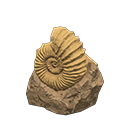Ammonite
The Ammonite is fossil display that can be donated to the Museum in Animal Crossing games. It consists of one part. Once the Ammonite has been donated to Blathers, it will be on display in your Museum.
| Ammonite Data | |
|---|---|
| Number of Parts | 1 |
| Fossil Parts |
|
| Part Size | 1x1 |
| Fung Shui Color 1 | Beige |
| Fung Shui Color 2 | Brown |
| HHA Points | 87 |
| Catalog | Not for sale |
| Sell Price |
|
Ammonite in Animal Crossing: New Horizons
Ammonite Fossil Information from Blathers in Animal Crossing: New Horizons
When you donate a Ammonite fossil to the Museum, Blathers tells you, "Ammonites were creatures that lived before and all the way through the age of dinosaurs! Because different species lived at different times, their shells are sometimes used as "index fossils.". In other words, these creatures act as markers in time, helping to identify the age of other formations! Who knows what other secrets lie hidden in those spiral shells?"
Ammonite Fossil Price in Animal Crossing: New Horizons
The Ammonite fossil sells for 1,100 Bells.
How to Get the Ammonite Fossil in Animal Crossing: New Horizons
You can get the Ammonite fossil in Animal Crossing: New Horizons by digging up unidentified fossils with a shovel on your island or on a Nook Miles Ticket mystery island. When you take the unidentified fossils to Blathers to assess, there is a chance that the fossil with be a Ammonite fossil. You can then donate your assessed fossil to the museum to complete your Ammonite fossil display or use duplicate fossils to decorate, send as gifts to another player or villager, or sell them at Nook's Cranny for extra bells.
Where is the Ammonite Fossil in the Museum in Animal Crossing: New Horizons?
The Ammonite fossil display is located in Room 1 of the Fossil wing of the Museum in Animal Crossing: New Horizons. The Ammonite will only be displayed in the Museum once you have donated it.
Ammonite Fossil Size in Animal Crossing: New Horizons
The Ammonite fossil is a 1x1 size item.
Happy Home Academy Information for the Ammonite Fossil in Animal Crossing: New Horizons
In Animal Crossing: New Horizons, the Ammonite fossil is worth a base value of 87 HHA points each when displayed in your home. It has a primary color of Beige and a secondary color of Brown when the Fung Shui value of your room is being calculated.
Ammonite Fossil Parts in Animal Crossing: New Horizons
Ammonite
 |
|
|---|---|
| Ammonite | |
| Buy Price | NFS |
| Sell Price | 1,100 |
| Interactable | No |
| Filename | FtrFossilAmmonoidea |
| ID | 295 |
The Ammonite fossil has a 1x1 size when placed as a furniture item. When placed in a player's house, the Ammonite is worth a base value of 87 HHA points, with Fung Shui colors of Beige and Brown. The is not an interactable furniture item.
In the Animal Crossing: New Horizon's game code, the Ammonite has the filename "FtrFossilAmmonoidea" and an internal ID number of 295.
Ammonite in Animal Crossing: New Leaf
In Animal Crossing: New Leaf, you will be able to read the museum plaque for the after donating all of the parts of the fossil. The T. Rex plaque reads, "Ammonites were sea creatures with shells ranging from a few inches to a few feet in diameter. However, theories speculate that giant varieties existed as well, with shells six feet in diameter. Oddly, the ammonite is a closer relative to the squid or octopus than to the chambered nautilus."
You can get the fossil parts in Animal Crossing: New Leaf by digging up unassessed fossils around your town with a shovel at dig spots. Each dig spot has a chance to contain a gyroid, a pitfall seed, or an unassessed fossil. You can take the unidentified fossils to Blathers to assess, and there is a chance that the fossil will be a fossil part. Once you have had Blathers assess the fossils, you can donate your assessed fossils to the museum to complete your or use duplicate fossils to decorate, send as gifts to another player or villager, or sell them at Re-Tail to get some extra bells.
The Ammonite IRL
Ammonites are marine molluscs that lived 400 to 65 million years ago. Their closest modern day relatives are the squid, cuttlefish, octopus and nautilus. They are popular because of their spiral shell which can resemble a ram’s horn. Throughout history their sizes varied greatly from millimeters to over 6.5 feet.
